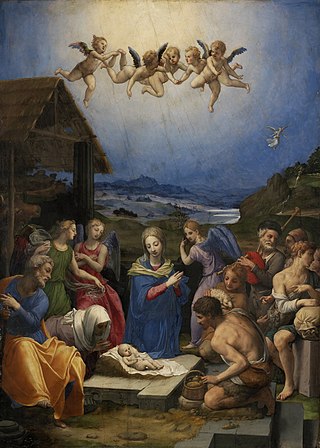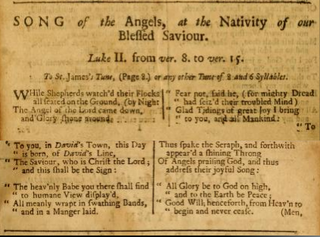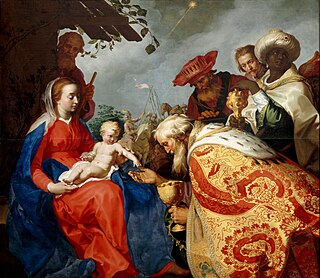Melody

"See, amid the Winter's Snow", also known as "The Hymn for Christmas", [1] is an English Christmas carol, written by Edward Caswall and first published in 1858. In 1871 Sir John Goss composed a hymn tune for it, "Humility", and as "Hymn for Christmas Day", it was included in Christmas Carols New And Old, the anthology edited by Henry Ramsden Bramley and John Stainer . [2]
Caswall wrote "See, amid the winter's snow" shortly after converting from the Church of England to the Roman Catholic Church and joining the Oratory of Saint Philip Neri. The hymn was published earliest in 1858 as part of The Masque of Mary and Other Poems by Caswall. [3] In 1871, John Goss wrote the tune "Humility" specifically for the carol. Later in the year, Bramley and Stainer selected "See, amid the winter's snow" to be published nationwide in their "Christmas Carols Old and New" hymn book. It was selected to be included in "Christmas Carols Old and New" as one of the carols that had "proved their hold upon the popular mind". [4] While the carol became popular, a number of verses were cut from later publications of "See, amid the Winter's Snow". This includes the original final verse about the Virgin Mary, which was often cut out of non-Catholic hymnals. [5]
The artist Edward Dalziel used the words of this hymn below his engraving of the English downland with animals, even though the engraving did not have any snow in it. [4]
The tune has been re-used in a variety of social protest and union songs in the late 20th century, beginning with "Coal, Not Dole", written in the mid-1980s by Kay Sutcliffe about the closing of the Kent coal fields to a tune by Paul Abrahams, but later reset to Goss's tune at the suggestion of John Tams and recorded by Coope Boyes and Simpson. [6] [7] Shelley Posen wrote "No More Fish, No Fishermen" in 1996 about the end of the cod fishery in Newfoundland. Australian John Warner wrote "Bring out the Banners" on the 150th anniversary of Australia's eight-hour work day rule in 1996. [8]
"See, amid the winter's snow" was initially composed with seven verses of four lines with a chorus after each one. [9] The chorus' line calls for the listener to "sing through all Jerusalem, Christ is born in Bethlehem". [1] Several hymnbooks do not contain all seven verses. [9] Goss gave advice in the music that the carol would be best performed solo by a "Treble or Tenor or, alternatively". [4] The writer J. R. Watson commented on study of the hymn that was an example of Caswell's objectivity. He also stated that the hymn develops a dialogue with the singers and the shepherds collectively rather than individually. [1] Aled Jones commented that the usage of snow in the carol was a message of purity against the sins of the world. [4]
The lyrics to this carol's usage in the majority of hymnals are as follows:
See, amid the winter's snow,
Born for us on Earth below,
See, the tender Lamb appears,
Promised from eternal years.
Chorus:
Hail, thou ever blessed morn,
Hail redemption's happy dawn,
Sing through all Jerusalem,
Christ is born in Bethlehem.
Lo, within a manger lies
He who built the starry skies;
He who, throned in height sublime,
Sits among the cherubim.
Hail…
Say, ye holy shepherds, say,
What your joyful news today;
Wherefore have ye left your sheep
On the lonely mountain steep?
Hail…
"As we watched at dead of night,
Lo, we saw a wondrous light:
Angels singing 'Peace On Earth'
Told us of the Saviour's birth."
Hail…
Sacred Infant, all divine,
What a tender love was Thine,
Thus to come from highest bliss
Down to such a world as this.
Hail…
Teach, O teach us, Holy Child,
By Thy face so meek and mild,
Teach us to resemble Thee,
In Thy sweet humility.
Hail…
Virgin Mother, Mary blest
By the joys that fill thy breast,
Pray for us, that we may prove
Worthy of the Saviour's love.
Hail…


Sir John Stainer was an English composer and organist whose music, though seldom performed today, was very popular during his lifetime. His work as choir trainer and organist set standards for Anglican church music that are still influential. He was also active as an academic, becoming Heather Professor of Music at Oxford.

"Hark! The Herald Angels Sing" is an English Christmas carol that first appeared in 1739 in the collection Hymns and Sacred Poems. The carol, based on Luke 2:14, tells of an angelic chorus singing praises to God. As it is known in the modern era, it features lyrical contributions from Charles Wesley and George Whitefield, two of the founding ministers of Methodism, with music adapted from "Vaterland, in deinen Gauen" of Felix Mendelssohn's cantata Festgesang.
"The First Nowell", modernised as "The First Noel" ", is a traditional English Christmas carol with Cornish origins most likely from the early modern period, although possibly earlier. It is listed as number 682 in the Roud Folk Song Index.

"What Child Is This?" is a Christmas carol with lyrics written by William Chatterton Dix in 1865 and set to the tune of "Greensleeves", a traditional English folk song, in 1871. Although written in Great Britain, the carol today is more popular in the United States than its country of origin.

"O sanctissima" is a Roman Catholic hymn in Latin, seeking the prayers of the Blessed Virgin Mary, and often sung in various languages on her feast days. The earliest known publication was from London in 1792, presenting it as a traditional song from Sicily; but no original source or date has been confirmed for the simple melody or the poetic text. The tune is often called "Sicilian Mariners Hymn" or similar titles, referring to the seafarers' nightly invocation of Mary as their maternal protector: Our Lady, Star of the Sea. The tune has been notably reused for the German Christmas carol "O du fröhliche" and the English recessional hymn "Lord, Dismiss Us With Thy Blessing", and appears to have been adapted as the first half of the American civil rights anthem "We Shall Overcome".

"Angels We Have Heard on High" is a Christmas carol to the hymn tune "Gloria" from a traditional French song of unknown origin called "Les Anges dans nos campagnes", with paraphrased English lyrics by James Chadwick. The song's subject is the birth of Jesus Christ as narrated in the Gospel of Luke, specifically the scene outside Bethlehem in which shepherds encounter a multitude of angels singing and praising the newborn child.

"Come Thou Fount of Every Blessing" is a Christian hymn written by the pastor and hymnodist Robert Robinson, who penned the words in the year 1758 at the age of 22.

Edward Caswall, CO, was a clergyman and hymn writer who converted to Catholicism and became an Oratorian priest. His more notable hymns include: "Alleluia! Alleluia! Let the Holy Anthem Rise"; "Come, Holy Ghost"; and "Ye Sons and Daughters of the Lord".

"Es ist ein Ros entsprungen" is a Christmas carol and Marian hymn of German origin. It is most commonly translated into English as "Lo, how a rose e'er blooming" and is also called "A Spotless Rose" and "Behold a Rose of Judah". The rose in the German text is a symbolic reference to the Virgin Mary. The hymn makes reference to the Old Testament prophecies of Isaiah, which in Christian interpretation foretell the Incarnation of Christ, and to the Tree of Jesse, a traditional symbol of the lineage of Jesus. Because of its prophetic theme, the hymn is popular during the Christian season of Advent.
"For the Beauty of the Earth" is a Christian hymn by Folliott S. Pierpoint (1835-1917).

"O come, O come, Emmanuel" is a Christian hymn for Advent, which is also often published in books of Christmas carols. The text was originally written in Latin. It is a metrical paraphrase of the O Antiphons, a series of plainchant antiphons attached to the Magnificat at Vespers over the final days before Christmas. The hymn has its origins over 1,200 years ago in monastic life in the 8th or 9th century. Seven days before Christmas Eve monasteries would sing the “O antiphons” in anticipation of Christmas Eve when the eighth antiphon, “O Virgo virginum” would be sung before and after Mary's canticle, the Magnificat. The Latin metrical form of the hymn was composed as early as the 12th century.

"While shepherds watched their flocks" is a traditional Christmas carol describing the Annunciation to the Shepherds, with words attributed to Irish hymnist, lyricist and England's Poet Laureate Nahum Tate. It is listed as number 16898 in the Roud Folk Song Index.
No More Fish, No Fishermen is a song whose lyrics were composed by Canadian folklorist and singer Shelley Posen, about the demise of the Newfoundland fishery. Although it was written in 1996, it is often assumed to be a traditional song. The tune is based upon "Coal Not Dole" by Kay Sutcliffe and Paul Abrahams, who wrote the lyrics and melody respectively, about the death of the coal industry in northern England. "Coal Not Dole" was made popular by Coope Boyes and Simpson on their Funny Old World album, and is in turn based on the Victorian Christmas carol, "See, Amid The Winter's Snow". It is set to the hymn tune Humility by John Goss, written in 1871.
"Gwahoddiad" is a Welsh hymn of American origin.
"As with Gladness Men of Old" is an Epiphany hymn, written by William Chatterton Dix on 6 January 1859 (Epiphany) while he was ill in bed. Though considered by many as a Christmas carol, it is found in the Epiphany section of many hymnals and still used by many churches. The music was adapted by William Henry Monk in 1861 from a tune written by Conrad Kocher in 1838. The hymn is based on the visit of the Biblical magi in the Nativity of Jesus.

Henry Ramsden Bramley was an English clergyman and hymnologist perhaps best known for his collaborations with the composer Sir John Stainer. Along with earlier 19th-century composers such as William Sandys and John Mason Neale, Bramley and Stainer are credited with fuelling a Victorian revival of Christmas carols with their 1871 publication of Christmas Carols, New and Old, which popularised carols such as "The First Nowell", "God Rest You Merry, Gentlemen" and "The Holly and the Ivy".

"The Babe in Bethlem's Manger", also called "The Babe in Bethlehem's Manger Laid", "Old Kentish Carol" and "The Saviour's Work", is an anonymous English folk Christmas carol celebrating the birth of Jesus in Bethlehem.
"The Rocking Carol", also known as "Little Jesus, Sweetly Sleep" and "Rocking", is an English Christmas carol by Percy Dearmer. It was translated from Czech in 1928 and is performed as a lullaby to the baby Jesus. The carol has also been known in English as the "Rocking" carol since an American edition in 1963. The carol has been recorded by Julie Andrews, Roger Whittaker and other artists.

"Earth Has Many a Noble City" is a Christian Epiphany hymn originally written by the Roman poet Aurelius Clemens Prudentius and translated by the English clergyman Edward Caswall in 1849.
St. Columba is a traditional Irish tune. It was first published by George Petrie in 1855, and it was republished in Charles Villiers Stanford's edited compilation of the tunes Petrie collected. It was described as having been "sung on the dedication of a chapel" in County Londonderry. The tune was paired with the hymn The King of Love My Shepherd Is in The English Hymnal (1906), and it rose in popularity with the hymn.